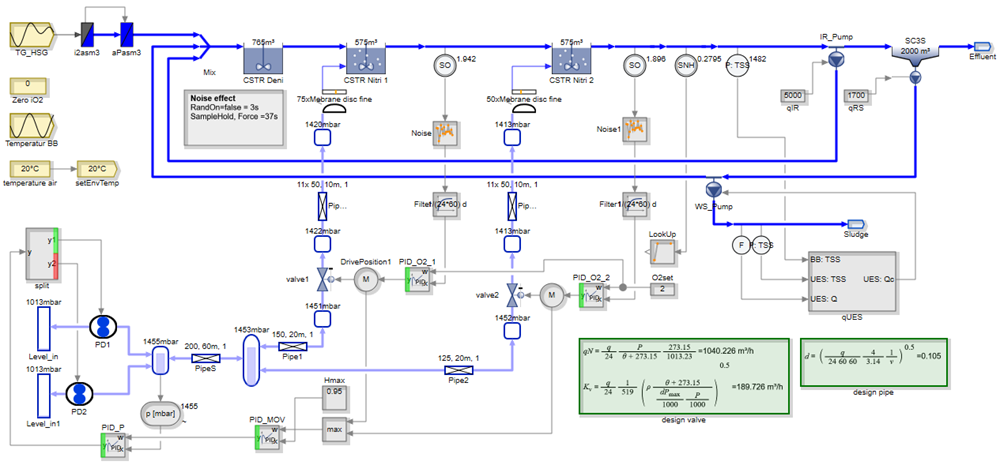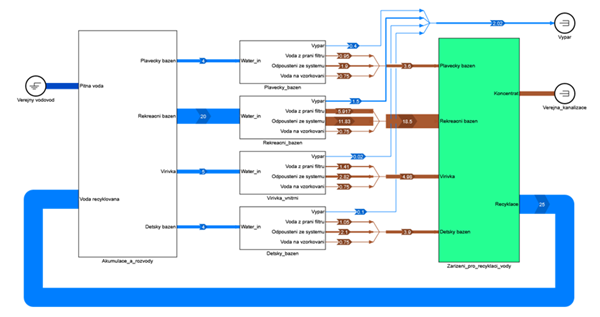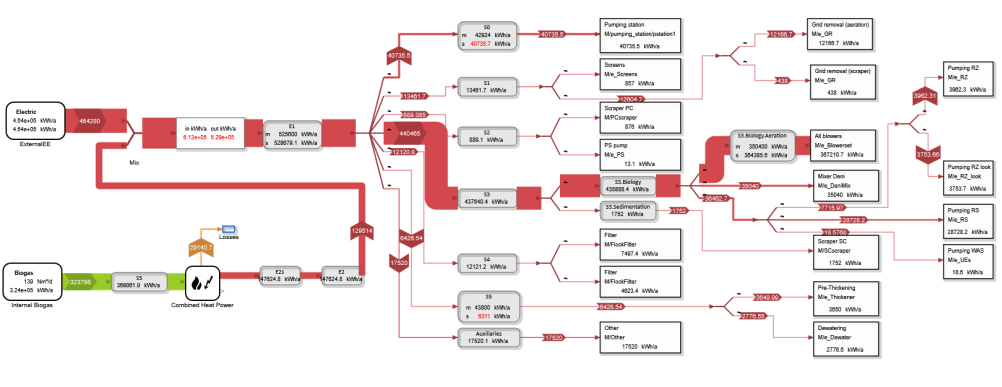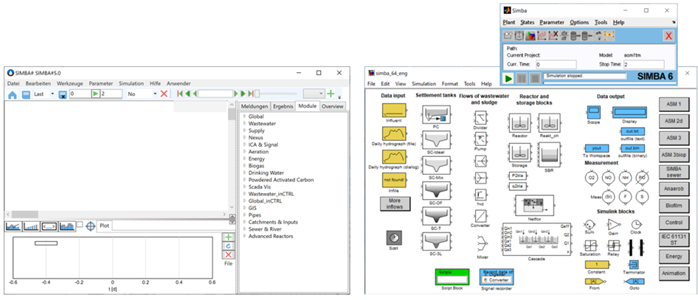SIMBA#
Simulation softwareSIMBA# – Simulation software for water and wastewater systems
The SIMBA# simulation system is a versatile software for modelling and dynamic simulation in the water and wastewater engineering. It integrates activated sludge models, aeration systems, sludge digestion, sewer networks, drinking water networks, rivers, biogas plants and any kind of automation solutions.
By simultaneous modelling of a wide variety of systems, including control concepts, SIMBA# allows an integrated view of all components, flows and material fluxes and well-founded process engineering, energy and control engineering analyses and optimisations.

Release SIMBA# 6.0
SIMBA#, the simulation system for innovative model-based solution concepts for manifold applications in the water, wastewater, energy and biogas areas has again reached a new milestone! The new version SIMBA# 6.0 not only brings continuous improvements and further developments of the existing functions, but also significantly extends the scope of SIMBA#. The release notes list the most important innovations.
What is SIMBA#
SIMBA# is the world’s leading integrated modelling and simulation platform for innovative model-based solution concepts in the water, wastewater and biogas sectors. The simultaneous modelling of a wide variety of systems (such as sewage treatment plants, sewer networks, drinking water networks, rivers and also biogas plants), including control concepts, allows an integrated view of all components, flows and material fluxes and well-founded process engineering, energy and control engineering analyses and optimisations.
In Germany and German-speaking countries, SIMBA# is widely used to support research and teaching activities in universities. From the point of view of practical application and with regard to the increasing requirements in the field of planning and operation of wastewater engineering plants, SIMBA# is being used more and more by water companies, wastewater associations and consultant engineers.
What is SIMBA#supply
SIMBA#supply is a specialised version of SIMBA# software aimed at modelling and calculating water, energy and other oriented balances not only in industrial companies. It offers the possibility to simulate industrial water distribution and treatment processes in a simple way and to optimize their operation with respect to energy and resource consumption. Another added value of water balance analysis using SIMBA#supply is the automatic creation of Sankey diagrams.
SIMBA#supply enables process engineers to, among other things, depending on the gradual provision of information about the analysed system, the gradual building of a balance model on the basis of which the overall balance of resources and consumption is automatically calculated. SIMBA#supply also allows, depending on the detail of the information provided, the gradual development of the balance model up to the detail of the subparts of the whole system, i.e. individual machines, storage tanks, control elements and other components of the analysed operation.

Water balance model of an industrial plant in SIMBA#supply
New features in SIMBA# 6.0
- E-Check Block Library: Support for energy analyses and energy checks according to the DWA A216 guideline. The library contains energy consumption models for all relevant aggregates and energy generation models and allows the description of energy balances of a wastewater treatment plant.
- Wastewater treatment plant hydraulics: Module library with the hydraulic components of wastewater treatment plants, stationary and dynamic calculation, consideration of special hydraulic situations
- Dynampere: Simplified analysis of energy concepts, mapping of energy generation and consumption as well as different energy types and energy storage systems
- Integration of AI tools: Modelling, learning and execution of Artificial Neural Networks
- Enhanced model for the elimination of trace substances: Improved models for the elimination of micropollutants with powdered activated carbon
- Digital twins: Online simulation coupled with real systems
- Additional features: New wastewater treatment plant influent model, improvements in the water chemistry library, new optimisation interface

Sankey diagram of the energy flows in a wastewater treatment plant
History
Since its first beginnings in 1994, the SIMBA simulation tool is now being used for research and application worldwide in the field of modelling and simulation of sewage treatment plants, sewer networks, rivers and agricultural biogas plants for more than 25 years. In its early years, SIMBA was a toolbox for the software tool MATLAB/Simulink, which is widely used in science. Since 2013, SIMBA# is now a technically independent solution and is also ideally suited for applications in daily engineering practice.

User interface and module library of SIMBA# 5.0 (left) and SIMBA (old version 6)
Advantages of SIMBA#
Due to its high flexibility, SIMBA# offers a wide range of benefits. These include, among others:
- Detailed mapping of the interaction of process engineering with the mechanical equipment (e.g. the aeration system) and planned automation functions
- Dimensioning and evaluation of wastewater treatment plants according to the DWA document T4/2016 “Dimensioning of wastewater treatment plants in warm and cold climate zones” (EXPOPLAN Tool)
- Compatible with DWA-A 131 guideline
- Inflow characterisation of municipal wastewater treatment plants based on the approach developed by the Central European researchers‘ Simulation Group (www.hsgsim.org)
- Real-time execution online for operational support with the open-source development ifakFAST (digital twin)
- Integrated consideration of sewer networks, sewage treatment plants and rivers for an immission-based analysis of urban wastewater systems
- GIS-based modelling for georeferenced representation of sewer networks, water bodies, drinking water networks, additionally representation of GIS shape files and bitmaps
- Digital elevation model (DEM) for the representation and use of elevation model information for the modelling of flows and material fluxes in supply and disposal infrastructures (e.g. sewer networks, drinking water networks)
- High flexibility and open source: use/extension of established models, development of user-specific models
- Modelling and simulation of many other processes (e.g. novel sanitation systems, industrial water systems, biogas plants)
- Modelling of interactions between liquid, gas and biofilm phases (multi-phase approach). This allows a whole range of new reactor types and processes to be modelled. The multiphase approach is particularly suitable for developing models for the treatment of industrial wastewater.
- Support for digitalisation processes (e.g. for the digitalisation of plant planning and operating processes).
- Extended Gujer process matrix editor
- Extensive functions for result evaluation
- Powerful graphical scripting tools, script execution via WEB apps
Modelling principle and model libraries
The structure of simulation models is based on the graphical interconnection of modules, each of which represents a process component (e.g. sewer section, primary treatment, aeration tank), to form a flow diagram.
- Activation processes in wastewater treatment (ASM1, ASM3, ASM3biop, …)
- Biofilm processes in wastewater treatment (MBBR, FBBR, MABR, TF, Granula)
- Anaerobic degradation processes (digestion), sludge treatment
- 4th treatment stage with activated carbon (PAC), process water treatment (Anammox)
- Wastewater transport, retention and mass transfer in sewer systems (hydrological and/or hydrodynamic)
- Water flow and quality in natural flowing waters
- A wide range of control functionalities including MBPC
- Aeration systems
- Pressure pipes and pumps
- Drinking water analyses
